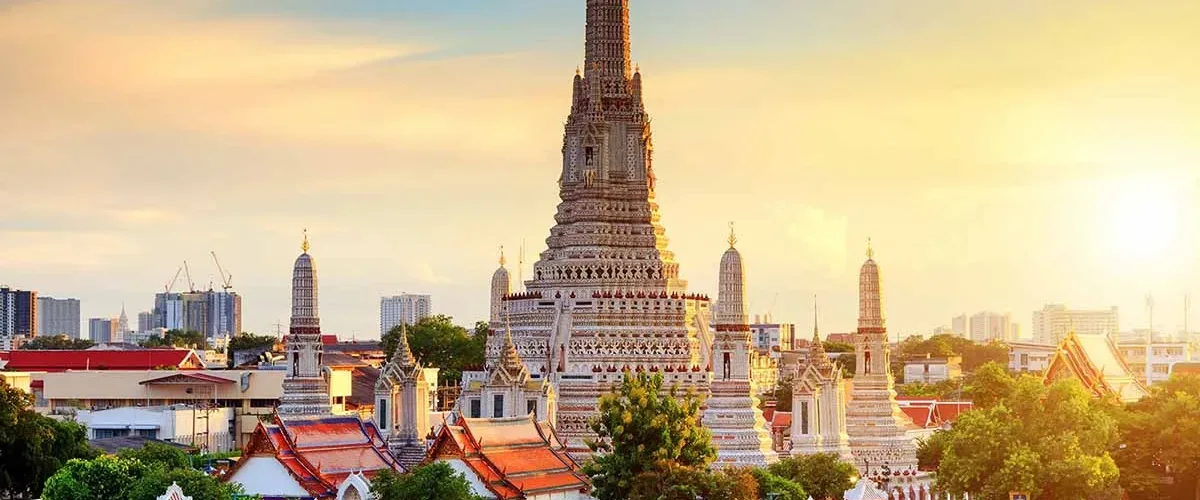Thailand’s weather is a story of contrasts — blazing sunshine, dramatic tropical showers, and skies so clear they look painted. Whether you’re dreaming of a sunny escape in Phuket, a temple-hopping adventure in Chiang Mai, or street food nights in Bangkok, timing matters.
This month-by-month guide helps you plan your trip around Thailand’s shifting seasons — from the cool calm of January to the lush, rainy vibrancy of September. Pack your sunscreen and your sense of humor — the weather here loves a surprise.
Quick Summary: Thailand Weather by Month (2026)
Thailand’s weather shifts with the seasons — cool and dry from November to February, hot and sunny from March to May, and lush and rainy from June to October. The best time to visit most regions is December to March for clear skies and beach-perfect days, while May to September offers lower prices, vibrant greenery, and fewer crowds.
You May Also Ask: Thailand Weather 2026
When is the best time to visit Thailand?
From December to March, when it’s dry, sunny, and ideal for both beaches and cities.
What is Thailand’s hottest month?
April is the hottest, especially in Bangkok and the central plains — perfect for the Songkran water festival.
Does it rain all day during Thailand’s monsoon?
No. Most rain falls in short bursts, often in the late afternoon or evening, leaving plenty of sunshine during the day.
Which islands are best to visit in July?
Head to the Gulf of Thailand — Koh Samui, Koh Phangan, and Koh Tao — where the weather is drier than on the Andaman side.
What is Thailand’s weather like in December?
December brings blue skies, mild temperatures, and calm seas — perfect for exploring Bangkok, Chiang Mai, and the southern beaches.
Quick Links: Central Thailand, North Thailand
January – Bright Beginnings and Cool Breezes

Weather: 21–30°C, low humidity, almost no rain.
Best for: First-timers, culture lovers, and beach hoppers.
January in Thailand is perfection. Blue skies stretch endlessly, the sea is calm, and cities buzz with lively energy. It’s the best time to explore everywhere — from the temples of Ayutthaya to the islands of the Andaman.
Expect peak prices and bustling spots — especially in Bangkok, Phuket, and Koh Phi Phi. But it’s worth every baht for those golden sunsets and warm evenings.
February – Golden Days, Endless Sunshine

Weather: 22–32°C, clear skies, almost no rainfall.
Best for: Romance, island escapes, and photography.
February is January’s charming twin — sunny, dry, and simply stunning. It’s perfect for island hopping in the Andaman Sea, or cultural adventures up north in Chiang Rai and Chiang Mai.
Valentine’s Day brings couples to Thailand’s beaches, while Chinese New Year can add color and crowds to Bangkok’s Chinatown.
March – The Warm-Up Begins

Weather: 25–34°C, mostly dry, warmer afternoons.
Best for: Early-summer vibes and quieter travel.
March turns up the heat — it’s officially “shoulder season.” The Gulf islands like Koh Samui and Koh Tao shine, while northern Thailand enters its “hazy days” from crop burning.
If air quality matters, stick to coastal escapes or central gems like Ayutthaya. It’s also an ideal month for budget travelers — great weather, lower prices, and fewer crowds.
April – Hot Days, Cool Festivals

Weather: 28–38°C (sometimes 40°C!), little rain.
Best for: Festivals, water fights, and lively city energy.
Welcome to Songkran season, Thailand’s famous water festival and New Year celebration. For a few joyful days, the whole country turns into one massive, good-natured water fight.
If you can handle the heat, April is unforgettable. Head for beach breezes in Krabi or Koh Samui to cool off between celebrations.
May – A Hint of Rain, A Lot of Charm

Weather: 26–35°C, early showers, humid afternoons.
Best for: Quiet travel and low-season bargains.
May marks the start of the green season, with short afternoon showers refreshing the air. It’s a sweet spot for travelers who prefer peace over crowds.
The Gulf islands — Koh Samui, Koh Phangan, and Koh Tao — stay relatively dry. Expect lush scenery, great hotel deals, and warm seas.
June – Rain Arrives (Softly, at First)

Weather: 25–33°C, short tropical bursts, greener landscapes.
Best for: Nature lovers, budget explorers.
The monsoon slowly tiptoes in. Expect refreshing rains in the afternoon — perfect for reading under palm trees. The Andaman Coast (Phuket, Krabi) gets wetter, while Gulf islands stay friendly.
This is the start of Thailand’s photographer’s paradise: waterfalls roar, rice paddies glow, and temples glisten under cloudy skies.
July – Tropical Rains & Tranquility

Weather: 25–32°C, frequent rain, especially in the west.
Best for: Quiet escapes and cozy resort stays.
July is peaceful — Thailand’s “slow season.” Prices drop, crowds vanish, and the landscape bursts into 50 shades of green.
While the Andaman coast gets soaked, the Gulf islands like Koh Samui are still manageable. If you’re seeking solitude, head north to Pai or explore cultural gems like Chiang Mai.
August – Rain, Romance, and Surprises

Weather: 24–31°C, regular showers but long sunny breaks.
Best for: Couples, long-term travelers, photographers.
August brings dramatic skies and lush beauty — ideal for travelers who love a bit of unpredictability. Despite the monsoon, European holidaymakers keep Thailand lively.
Stick to the Gulf of Thailand for a balance of sun and rain, and enjoy uncrowded temples and vibrant local life everywhere else.
September – Wet, Wild, and Wonderfully Green

Weather: 23–31°C, the wettest month.
Best for: Budget travel and offbeat adventures.
Yes, September is wet — but also beautifully quiet. Waterfalls thunder, rice terraces shine, and Thailand’s jungles feel alive.
You’ll need flexibility and a raincoat, but you’ll be rewarded with low prices and a peaceful version of Thailand that few tourists see.
October – The Great Refresh

Weather: 22–32°C, rains fade, skies clear.
Best for: Northern Thailand adventures.
October is Thailand’s “rebirth month.” The rain retreats, temperatures ease, and everything sparkles. It’s the best time to visit Chiang Mai, Chiang Rai, and the scenic mountain town of Pai.
Meanwhile, the Andaman Coast begins drying out — a great preview of the coming high season.
November – Sunshine Returns

Weather: 21–31°C, cool breezes, bright skies.
Best for: Festivals, sightseeing, and photography.
November marks the beginning of Thailand’s best travel window. Loy Krathong, the magical lantern festival, lights up rivers across the country — especially in Chiang Mai.
It’s also the time to rediscover Bangkok without melting. Expect perfect weather from sunrise to sunset.
December – Picture-Perfect Thailand

Weather: 20–30°C, clear skies, no rain.
Best for: Everyone, everywhere.
December is Thailand’s grand finale — flawless weather, festive energy, and postcard-perfect beaches. The islands glitter, the cities hum, and the mood is pure celebration.
It’s peak season, so book early — whether you’re ringing in the New Year on Phuket’s beaches or wandering Bangkok’s temples.
Final Thoughts – Thailand, All Year Round
Thailand doesn’t really have a bad time to visit — just different moods. The dry months (November–April) promise postcard perfection, while the rainy season (May–October) unveils a greener, quieter Thailand that’s just as magical.
If you crave beach days, go for the Andaman coast in winter or the Gulf islands in summer. If you love mountains and misty mornings, northern Thailand from October to February will steal your heart.
No matter when you visit, Thailand will greet you with warmth — sometimes from the sun, sometimes from the people. 🌴
For more regional insights, explore:
Thailand Weather – Frequently Asked Questions
The best months to visit Thailand in 2026 are December to March, when the weather is dry, sunny, and comfortable across most regions. These months offer ideal conditions for exploring Bangkok, Chiang Mai, and the southern islands like Phuket or Koh Samui.
Thailand’s rainy season runs from June to October, though it varies slightly by region. The Andaman Coast (Phuket, Krabi) sees the heaviest rain from July to September, while the Gulf of Thailand (Koh Samui, Koh Phangan) stays relatively dry until late October.
Yes! The rainy season can be a wonderful time to visit. While you’ll get short tropical showers, the landscapes are lush, waterfalls are at their best, and prices are much lower. Chiang Mai, Pai, and Koh Samui remain great choices for 2026 monsoon travelers.
April is Thailand’s hottest month, with daytime temperatures often exceeding 38°C (100°F). It’s also when Thailand celebrates Songkran, the world-famous water festival — a fun way to cool off while joining locals in nationwide water fights!
The coolest months are December and January, especially in northern regions like Chiang Rai and Chiang Mai, where temperatures can drop below 15°C at night. In the south, it’s warm and breezy — perfect for beaches.
The cheapest time to visit Thailand is during the green season (May to October). Fewer tourists, lower hotel rates, and beautiful scenery make this period ideal for budget-conscious travelers. Just pack a light rain jacket and enjoy quieter beaches.
During the European summer (June–August), the Gulf of Thailand side — especially Koh Samui, Koh Phangan, and Koh Tao — enjoys less rain and calmer seas compared to the Andaman Coast.
The best time to visit Bangkok is November to February, when temperatures are mild and humidity is lower. These months are ideal for sightseeing, dining by the Chao Phraya River, and exploring markets and temples in comfort.
Pack light, breathable clothing, sandals, and a light rain jacket if traveling between May and October. Include modest clothes for temple visits, sunscreen, and insect repellent. A compact umbrella is handy year-round — Thailand’s weather can surprise you!
Yes — Thailand has a tropical climate, so it’s warm year-round. Even in the cool season, average daytime temperatures stay around 25–30°C. The variation comes from humidity and rainfall rather than cold weather.
